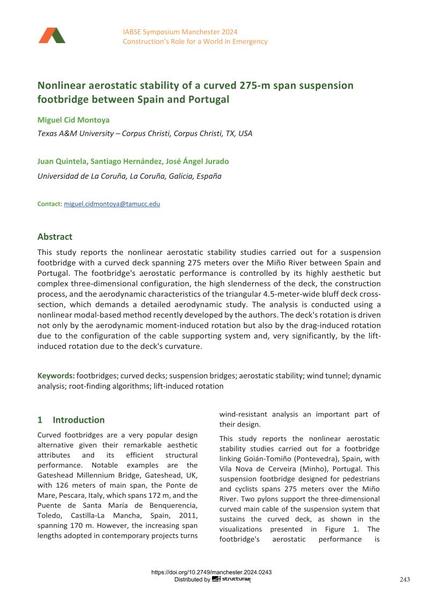Nonlinear aerostatic stability of a curved 275-m span suspension footbridge between Spain and Portugal

|
|
|||||||||||
Bibliografische Angaben
| Autor(en): |
Miguel Cid Montoya
(Texas A&M University – Corpus Christi, Corpus Christi, TX, USA)
Juan Quintela (Universidad de La Coruña, La Coruña, Galicia, España) Santiago Hernández (Universidad de La Coruña, La Coruña, Galicia, España) José Ángel Jurado (Universidad de La Coruña, La Coruña, Galicia, España) |
||||
|---|---|---|---|---|---|
| Medium: | Tagungsbeitrag | ||||
| Sprache(n): | Englisch | ||||
| Tagung: | IABSE Symposium: Construction’s Role for a World in Emergency, Manchester, United Kingdom, 10-14 April 2024 | ||||
| Veröffentlicht in: | IABSE Symposium Manchester 2024 | ||||
|
|||||
| Seite(n): | 243-251 | ||||
| Anzahl der Seiten (im PDF): | 9 | ||||
| DOI: | 10.2749/manchester.2024.0243 | ||||
| Abstrakt: |
This study reports the nonlinear aerostatic stability studies carried out for a suspension footbridge with a curved deck spanning 275 meters over the Miño River between Spain and Portugal. The footbridge's aerostatic performance is controlled by its highly aesthetic but complex three-dimensional configuration, the high slenderness of the deck, the construction process, and the aerodynamic characteristics of the triangular 4.5-meter-wide bluff deck cross- section, which demands a detailed aerodynamic study. The analysis is conducted using a nonlinear modal-based method recently developed by the authors. The deck's rotation is driven not only by the aerodynamic moment-induced rotation but also by the drag-induced rotation due to the configuration of the cable supporting system and, very significantly, by the lift- induced rotation due to the deck's curvature. |
||||
| Stichwörter: |
Fußgängerstege Fußgängerbrücken Windkanal dynamische Berechnung
|
||||
